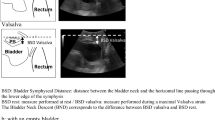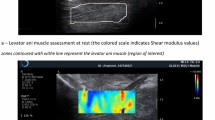Abstract
Introduction and hypothesis
The internal pudendal artery (IPA) is one of the main arteries supplying the pelvic floor muscles (PFMs) and vulvo-vaginal tissues. Its assessment with color Doppler ultrasound has been documented previously, but the reliability of IPA measurements has never been assessed. This study evaluates the test–retest reliability of IPA blood flow parameters measured by color Doppler ultrasound under two conditions: at rest and after a PFM contraction task.
Methods
Twenty healthy women participated in this study. One observer performed two measurement sessions using a clinical ultrasound system with a curved-array probe on the participant’s gluteal area. IPA measurements were repeated: at rest and after a PFM contraction task. Peak systolic velocity (PSV), time-averaged maximum velocity (TAMX), end-diastolic velocity (EDV), pulsatility index (PI), and resistance index (RI) were measured. Test–retest reliability was assessed using a paired t test, intraclass correlation coefficient (ICC), and Bland and Altman plots.
Results
There was no significant difference for all IPA blood flow measurements between the two repeated sessions. At rest, reliability was excellent for PSV and TAMX and the variability between measurements, as per Bland and Altman plots, was small. After PFM contractions, reliability was excellent for PSV and TAMX and fair to good for PI. The variability between measurements was small for PSV and acceptable for TAMX and PI. EDV and RI parameters did not perform as well.
Conclusion
The assessment of IPA blood flow with color Doppler ultrasound to evaluate vascular change in women is reliable.



Similar content being viewed by others
References
Culligan W. The big picture: gross anatomy. Yale J Biol Med. 2013;86(2):285–6.
Kovacs P, Gruber H, Piegger J, Bodner G. New, simple, ultrasound-guided infiltration of the pudendal nerve. Dis Colon Rectum. 2001;44(9):1381–5.
Rofaeel A, Peng P, Louis I, Chan V. Feasibility of real-time ultrasound for pudendal nerve block in patients with chronic perineal pain. Reg Anesth Pain Med. 2008;33(2):139–45.
Portman DJ, Gass MLS. Vulvovaginal atrophy terminology consensus conference P. Genitourinary syndrome of menopause: new terminology for vulvovaginal atrophy from the International Society for the Study of Women's sexual health and the North American Menopause Society. J Sex Med. 2014;11(12):2865–72.
Palmer AR, Likis FE. Lactational atrophic vaginitis. J Midwifery Womens Health. 2003;48(4):282–4.
Mollo M, Bautrant E, Rossi-Seignert A-K, Collet S, Boyer R, Thiers-Bautrant D. Evaluation of diagnostic accuracy of colour duplex scanning, compared to electroneuromyography, diagnostic score and surgical outcomes, in pudendal neuralgia by entrapment: a prospective study on 96 patients. Pain. 2009;142(1):159–63.
Erol B, Tefekli A, Ozbey I, Salman F, Dincag N, Kadioglu A, et al. Sexual dysfunction in type II diabetic females: a comparative study. J Sex Marital Ther. 2002;28(S1):55–62.
Graziottin A, Lukasiewicz M, Serafini A. Sexual rehabilitation after gynaecological cancers. In: Reisman Y, Gianotten WL, editors. Cancer, intimacy and sexuality. Heidelberg: Springer; 2017. p. 205–22.
Goldstein I, Berman J. Vasculogenic female sexual dysfunction: vaginal engorgement and clitoral erectile insufficiency syndromes. Int J Impot Res. 1998;10:S84–90. discussion S98–101.
Pieterse Q, Ter Kuile M, Deruiter M, Trimbos J, Kenter G, Maas C. Vaginal blood flow after radical hysterectomy with and without nerve sparing. A preliminary report. Int J Gynecol Cancer. 2008;18(3):576–83.
North American Menopause Society. Management of symptomatic vulvovaginal atrophy: 2013 position statement of The North American Menopause Society. Menopause. 2013;20(9):888–902.
Gambacciani M, Palacios S. Laser therapy for the restoration of vaginal function. Maturitas. 2017;99:10–5.
Moore DJ, Gonzales JU, Tucker SH, Elavsky S, Proctor DN. Exercise-induced vasodilation is associated with menopause stage in healthy middle-aged women. Appl Physiol Nutr Metab. 2012;37(3):418–24.
Parker BA, Smithmyer SL, Ridout SJ, Ray CA, Proctor DN. Age and microvascular responses to knee extensor exercise in women. Eur J Appl Physiol. 2008;103(3):343–51.
Egginton S. Invited review: activity-induced angiogenesis. Pflugers Arch. 2008;457(5):963–77.
Battaglia C, Nappi RE, Mancini F, Cianciosi A, Persico N, Busacchi P, et al. Menstrual cycle-related morphometric and vascular modifications of the clitoris. J Sex Med. 2008;5(12):2853–61.
Daniels JW, Molé PA, Shaffrath JD, Stebbins CL. Effects of caffeine on blood pressure, heart rate, and forearm blood flow during dynamic leg exercise. J Appl Physiol. 1998;85(1):154–9.
Sørensen LT, Jørgensen S, Petersen LJ, Hemmingsen U, Bülow J, Loft S, et al. Acute effects of nicotine and smoking on blood flow, tissue oxygen, and aerobe metabolism of the skin and subcutis. J Surg Res. 2009;152(2):224–30.
Hoffman MD, Sheldahl LM, Kraemer WJ. Therapeutic exercise. In: DeLisa JA, Gans BM, Walsh NE, Bockenek WL, Frontera WR, Geiringer SR, et al., editors. Physical medicine & rehabilitation: principles and practice. 1. 4th edition. Philadelphia: Lippincott Williams & Wilkins; 2005. p. 389–432.
Berman J, Berman L, Werbin T, Flaherty E, Leahy N, Goldstein I. Clinical evaluation of female sexual function: effects of age and estrogen status on subjective and physiologic sexual responses. Int J Impot Res. 1999;11(Suppl 1):S31–S8.
Birk G, Dawson E, Batterham A, Atkinson G, Cable T, Thijssen D, et al. Effects of exercise intensity on flow mediated dilation in healthy humans. Int J Sports Med. 2013;34(5):409–14.
Johnson BD, Wallace JP. A comparison of postexercise shear rate patterns following different intensities and durations of running in healthy men. Clin Physiol Funct Imaging. 2012;32(3):234–40.
Currie KD, McKelvie RS, MacDonald MJ. Flow-mediated dilation is acutely improved after high-intensity interval exercise. Med Sci Sports Exerc. 2012;44(11):2057–64.
De Vet HCW, Terwee CB, Knol DL, Bouter LM. When to use agreement versus reliability measures. J Clin Epidemiol. 2006;59(10):1033–9.
Fleiss JL. The design and analysis of clinical experiments. New York: Wiley; 1986.
Bland JM, Altman D. Statistical methods for assessing agreement between two methods of clinical measurement. Lancet. 1986;327(8476):307–10.
Currier DP. Elements of research in physical therapy. Baltimore: Williams & Wilkins; 1984.
Dumoulin C, Moore K. Adult Conservative Management In: Paul A, Linda C, Saad K, Alan W, editors. Incontinence, 5th International Consultation on Incontinence, Paris; 2013. p. 1103–073.
Green DJ, Spence A, Halliwill JR, Cable NT, Thijssen DHJ. Exercise and vascular adaptation in asymptomatic humans. Exp Physiol. 2011;96(2):57–70.
Prior BM, Yang HT, Terjung RL. What makes vessels grow with exercise training? J Appl Physiol. 2004;97(3):1119–28.
Acknowledgements
The authors would like to thank the women who participated in the present study. Joanie Mercier was supported by a scholarship from the Quebec Network for Research on Aging, An Tang was supported by a research scholarship from the Fonds de Recherche du Québec en Santé and Fondation de l’association des radiologistes du Québec (FRQS-ARQ #26993), and Mélanie Morin was supported by a research scholarship from the Fonds de Recherche du Québec en Santé.
Funding
This study was funded by the Quebec Network for Research on Aging.
Author information
Authors and Affiliations
Corresponding author
Ethics declarations
Conflicts of interest
None.
Rights and permissions
About this article
Cite this article
Mercier, J., Tang, A., Morin, M. et al. Test–retest reliability of internal pudendal artery blood flow using color Doppler ultrasound in healthy women. Int Urogynecol J 29, 1817–1824 (2018). https://doi.org/10.1007/s00192-018-3615-5
Received:
Accepted:
Published:
Issue Date:
DOI: https://doi.org/10.1007/s00192-018-3615-5




